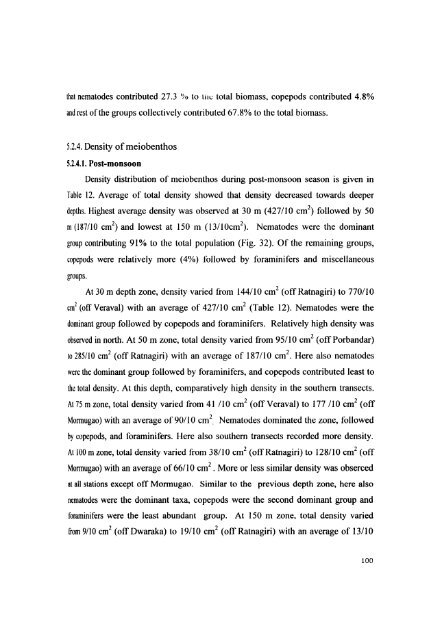L - Cochin University of Science and Technology
L - Cochin University of Science and Technology
L - Cochin University of Science and Technology
Create successful ePaper yourself
Turn your PDF publications into a flip-book with our unique Google optimized e-Paper software.
that nematodes contributed 27.3 (10 to lill; total biomass, copepods contributed 4.8%<br />
<strong>and</strong> rest <strong>of</strong> the groups collectively contributed 67.8% to the total biomass.<br />
5.2.4. Density <strong>of</strong> meiobenthos<br />
5.2.4.1. Post-monsoon<br />
Density distribution <strong>of</strong> meiobenthos during post-monsoon season is given in<br />
Table 12. Average <strong>of</strong> total density showed that density decreased towards deeper<br />
depths. Highest average density was observed at 30 m (427/10 cm 2 ) followed by 50<br />
m (187/10 cm 2 ) <strong>and</strong> lowest at 150 m (l3/10cm\ Nematodes were the dominant<br />
group contributing 91 % to the total population (Fig. 32). Of the remaining groups,<br />
copcpods were relatively more (4%) followed by foraminifers <strong>and</strong> miscellaneous<br />
groups.<br />
At 30 m depth zone, density varied from 144110 cm 2 (<strong>of</strong>f Ratnagiri) to 770/10<br />
cm 2 (<strong>of</strong>T Veraval) with an average <strong>of</strong> 427/10 cm 2 (Table 12). Nematodes were the<br />
dominant group followed by copepods <strong>and</strong> ioraminifers. Relatively high density was<br />
observed in north. At 50 m zone, total density varied from 95110 cm 2 (otIPorb<strong>and</strong>ar)<br />
to 285/10 cm 2 (<strong>of</strong>f Ratnagiri) with an average <strong>of</strong> 187110 cm 2 . Here also nematodes<br />
were the dominant group followed by foraminifers, <strong>and</strong> copepods contributed least to<br />
the total density. At this depth, comparatively high density in the southern transects.<br />
At 75 m zone, total density varied from 41 110 cm 2 (<strong>of</strong>TVeravai) to 177 110 cm 2 (<strong>of</strong>T<br />
Mormugao) with an average <strong>of</strong> 90/10 cm 2 , Nematodes dominated the zone, followed<br />
by copepods, <strong>and</strong> foraminifers. Here also southern transects recorded more density.<br />
At lOO m zone, total density varied from 38/10 cm 2 (<strong>of</strong>f Ratnagiri) to 128110 cm 2 (<strong>of</strong>f<br />
Mormugao) with an average <strong>of</strong> 66/10 cm 2 • More or less similar density was obserced<br />
at all stations except <strong>of</strong>f Mormugao. Similar to the previous depth zone, here also<br />
nematodes were the dominant taxa, copepods were the second dominant group <strong>and</strong><br />
foraminifers were the least abundant group. At 150 m zone, total density varied<br />
from 9/10 cm 2 (<strong>of</strong>f Dwaraka) to 19/10 cm 2 (<strong>of</strong>T Ratnagiri) with an average <strong>of</strong> 13/10<br />
100

















